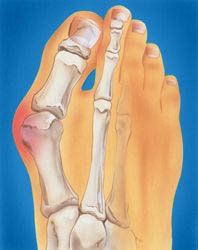Bunions (Hallux Valgus)
What is Bunions (Hallux Valgus)?
Even though bunions are a common foot deformity, there are misconceptions about them. Many people may unnecessarily suffer the pain of bunions for years before seeking treatment.
A bunion is often described as a bump on the side of the big toe. But a bunion is more than that. The visible bump reflects changes in the bony framework of the front part of the foot. The big toe leans toward the second toe, rather than pointing straight ahead. This throws the bones out of alignment – producing the bunion’s “bump.”
Bunions are a progressive disorder. They begin with a leaning of the big toe, gradually changing the angle of the bones over the years and slowly producing the characteristic bump. Symptoms usually appear at later stages, although some people never have symptoms.

Causes
Bunions are most often caused by an inherited faulty mechanical structure of the foot. It is not the bunion itself that is inherited, but certain foot types that make a person prone to developing a bunion.
Although wearing shoes that crowd the toes won’t actually cause bunions, it sometimes makes the deformity get progressively worse.
Symptoms
Symptoms may include:
- Pain or soreness.
- Inflammation and redness.
- A burning sensation.
- Numbness.
Symptoms occur most often when wearing shoes that crowd the toes, explaining why women are more likely to have symptoms than men. In addition, spending long periods of time on your feet can aggravate the symptoms of bunions.
Diagnosis
Bunions are readily apparent – the prominence is visible at the base of the big toe or side of the foot. However, to fully evaluate the condition, the foot and ankle surgeon may take x-rays to determine the degree of the deformity and assess the changes that have occurred.
Because bunions are progressive, they don’t go away, and will usually get worse over time. Once your surgeon has evaluated your bunion, a treatment plan can be developed that is suited to your needs.
Non-surgical Treatment
Sometimes observation of the bunion is all that’s needed. In many other cases, however, some type of treatment is needed. Early treatments are aimed at easing the pain of bunions, but they won’t reverse the deformity itself. These include:
- Changes in shoe wear.
- Padding.
- Activity modifications. Avoid activity that causes bunion pain, including standing for long periods of time.
- Medications.
- Icing.
- Injection therapy. Although rarely used in bunion treatment, injections of corticosteroids may be useful in treating the inflamed bursa (fluid-filled sac located around a joint) sometimes seen with bunions.
- Orthotic devices.
When is Surgery Needed?
Bunions are readily apparent – the prominence is visible at the base of the big toe or side of the foot. However, to fully evaluate the condition, the foot and ankle surgeon may take x-rays to determine the degree of the deformity and assess the changes that have occurred.
Because bunions are progressive, they don’t go away, and will usually get worse over time. Once your surgeon has evaluated your bunion, a treatment plan can be developed that is suited to your needs.


